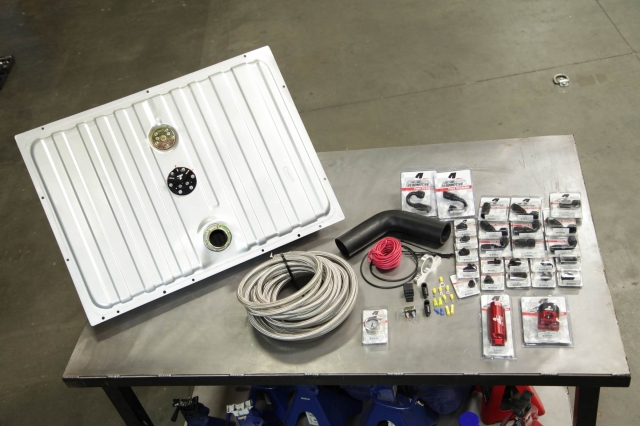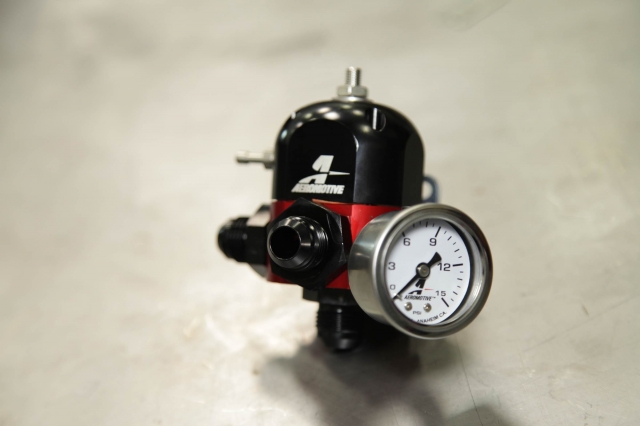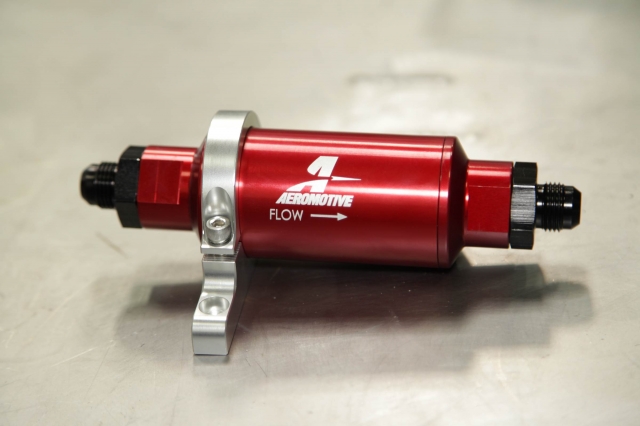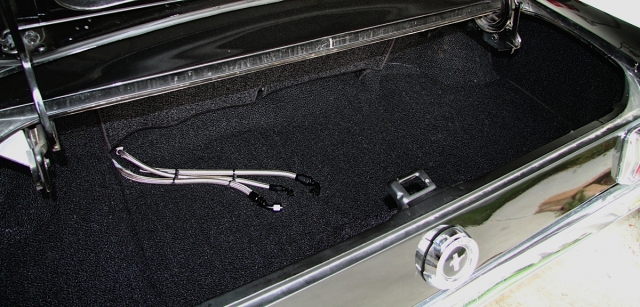
Whether you’re upgrading a fuel system for more horsepower, an engine swap, or due to age, the time eventually comes for every muscle car owner. Upgrading to a better mechanical pump on a classic Mustang has always been an option, and we’ve seen plenty of sumped stock or reproduction tanks, as well as full custom tanks through the years. Aeromotive has recently been adding more Stealth fuel tanks to their production line, offering a new alternative. Those options now include a new tank and pump package for classic first generation Mustangs, which we’ll be installing in this article.

Everything needed for the Stealth system conversion including the new tank and pump, braided hose, fuel filter, fittings, and fuel pressure regulator.
Going Stealth
The Stealth system is ideal for muscle car enthusiasts because it covers everything from 200 horsepower six-cylinder engines, all the way up to modified, EFI forced induction l engines. -Jesse Powell, Aeromotive
The Aeromotive Stealth fuel system offers muscle car enthusiasts the performance they demand, in a package that doesn’t require them to perform major surgery on their car like hacking up the floor to fit a fuel cell, or cutting into an existing tank to add a sump.
In the case of the Mustang system we’re installing for this article, part number 18697 includes a new tank built around the production dimensions, but with a few changes. Aeromotive has added a baffling and tray system to keep the fuel pump submerged. “This is a reproduction replacement tank that has been engineered for an in-tank pump. By doing this we have eliminated the need to sump an old tank, cut into a new tank, or have a custom fuel tank built,” says Aeromotive’s Jesse Powell.
The fuel pump is one of their 340 liter per hour Stealth pumps. Powell tells us, “The Stealth system is ideal for muscle car enthusiasts because it covers everything from 200 horsepower six-cylinder engines, all the way up to modified, and even forced induction late model engine swaps.”
Left: The Stealth tank is based around a reproduction tank design with a baffle system added to keep the fuel pump covered in fuel under all driving conditions. Right: The heart of the Stealth system is the 340 lph pump, mounted to a billet aluminum, anodized bracket.
The turbine style Stealth 340 pump is capable of supporting as much as 1,000 hp in naturally aspirated carbureted applications, 800 hp in forced induction carbureted applications, 850 hp in naturally aspirated EFI applications, and 700 hp with EFI and forced induction. The versatility of being compatible with EFI or carburetors, as well as the high horsepower handling capability make the Stealth 340 pump ideally suited for a large number of muscle car enthusiasts in a wide array of applications.
The pump sits in an anodized billet aluminum hanger, and for classic Mustangs the tank also features a 73-10 ohm fuel level sending unit already built in. There’s also a bolt on flanged filler neck adapter, and a 60 degree rubber filler neck connector is included. The pump hanger features orb AN ports for supply, return, and vent, making it easy to plumb the fuel system with the appropriate size line.
Left: The Stealth tank includes a 73-10 ohm sending unit already installed in the tank. Right: The Stealth pump includes the necessary ports for the fuel supply line, return, and vent.
Going In Tank
For years Aeromotive has offered a variety of external fuel pumps, and continues to do so. However, as Powell points out going in-tank allows for a variety of advantages in street cars. “OEM’s have been using in-tank pumps since the mid-1980s, going in tank keeps the pump cooler, and eliminates a lot of the problems that commonly arise from improper installation of the pump.”
According to Powell, mounting the pump in the tank allows the pump to remain constantly submerged in fuel, taking fuel starvation due to fuel slosh out of the equation. The positive pressure environment of the pump being submerged in the tank raises the boiling point of the fuel. This means that even if engine and ambient air temperatures raise the fuel temperature, the chances of the fuel boiling and causing vapor related issues is highly unlikely.

Since the Stealth pump can support EFI or a carburetor, we’re using an Aeromotive A1000 fuel pressure regulator to step pressure down to a safe level for the carburetor.
Placing the pump in the tank also allows for easier installation. According to Powell, the majority of problems Aeromotive deals with on their tech line is from an in-line pump that has been improperly installed. This is in large part due to the external pumps being a pusher style pump, meaning they need to be gravity fed from the fuel tank. Mounting a pump low on a street-going car has the potential to create a ground clearance issue. If the tank is not properly sumped or baffled, it can also leave the pump, and the engine starved for fuel under hard cornering, braking, or acceleration forces.
Supporting Cast
Installing the Stealth tank and pump also requires upgrading the remaining components of the fuel system as well. To that end we’re using -8 steel braided line from Aeromotive, part number 15706, to deliver the fuel as well as for the return line. We’re also using an Aeromotive fuel pressure regulator, and in-line filter as well as several of their fittings and other components needed to plumb the system.
The 10 micron filter, part number 12301, will ensure that anything not caught by the fuel pump’s sock filter inside the tank won’t make it’s way to our regulator and carburetor. This filter features a replaceable element, making it easy to service periodically. It can also flow up to 2,000 lbs per hour of fuel with less than a 1 psi pressure drop, making it capable of supporting applications well above ours. For installation and fuel system design purposes it’s important to note that a 10 micron filter is the only type that should be installed after the fuel pump to prevent a line restriction. Since this filter comes ready to accept -10 AN fittings we had to install two -8 fittings for our fuel system. We hung the filter using an Aeromotive billet fuel filter mounting bracket, part number 12305.

Keeping debris out of the fuel system will be this Aeromotive 10 micron fuel filter, which we’ll mount inline near the front of the car using one of their billet mounting brackets.
The fuel pressure regulator we chose is part number 13204. This is Aeromotive’s A1000 regulator and is adjustable from 3 to 15 psi, it can also be boost referenced for blow-through carburetor systems. This regulator features one -10 AN inlet port, and two -6 AN outlet ports, as well as a 1/8-inch NPT port for a fuel pressure gauge. We’ll be keeping an eye on fuel pressure with an Aeromotive 0-15 psi fuel pressure gauge, part number 15632.
Top Row: Left: We begin by removing the old fuel tank from the trunk of the car. Center: The old fuel lines will also need to be removed. Right: It may be necessary to cut some of the old fuel lines to remove them. Bottom Row: Left: We also removed the old fuel lines at the carburetor. Center: The old mechanical fuel pump must be removed and a block-off plate installed on the timing cover. Right: Side by side you can see the difference between the -8 line we're installing and the stock 3/16-inch metal fuel line.
Installation
Our installation subject is a ’65 Mustang Fastback that belongs to Engine Labs editor Mike Magda. Magda has plans for a much more powerful engine in the near future, and the Aeromotive Stealth fuel system we’re installing will compliment that upgrade nicely. We’ve outlined the entire installation process with the included photos and captions, but we’ll cover some of the highlights here.
Top Row: Left: The new tank was easily installed and fit without any modifications to the car. Center: We routed our new braided lines under the car. Right: The filter was mounted near the driver's front subframe. Bottom Row: Left: We used fittings to get our fuel lines pointed in the proper direction coming off the top of the fuel pump. Center: The fuel pressure regulator was mounted next to the brake master cylinder for easy access. Right: Once we had flushed the new lines out to remove any debris, we connected everything front to rear and at the tank.
Going Electric
Aeromotive provided us with their 30 amp fuel pump wiring kit, part number 16301. This kit includes, a relay and fuse, and is easily added to the car, and triggered by the ignition switch being placed in the run position. This allows us to install the fuel system properly, and safely, and will ensure the pump shuts down when we turn the key off, and comes to life whenever it’s time to fire up the car.
On classic Mustangs the fuel tank is installed through the trunk, with the top of the tank actually making up the trunk floor area. This makes removing the old tank, and installing the new one rather simple.
We routed our -8 fuel lines along the driver side of the car, keeping away from exhaust, the driveshaft, and suspension components as needed. The fuel filter was mounted close to the driver side front subframe using the billet mounting bracket, and the fuel pressure regulator was mounted to the driver side of the firewall next to the brake master cylinder.
The fuel filler easily connected to the original fuel filler stem that comes off the rear trunk panel. With all of our lines plumbed, we flushed the fuel system to remove any debris, then set the fuel pressure regulator for 6 psi. With the fuel pressure set we fired up the car, checked for leaks and went for a test drive.
Finishing Touch
We decided not to leave the trunk floor bare, so we turned to Mustangs Unlimited for one of their trunk carpet kits part number TC6507. This kit includes the carpet for the back of the Fastback fold down seats as well as the sides of the trunk and the trunk floor. The carpet is made of a Nylon/Raylon blend for long life, durability, and color stability.
Clockwise from top left: The Mustangs Unlimited carpet kit includes sections to line entire trunk space. Holes for the fittings were cut and trimmed before final hose installation. The carpet sides are mounted to fiberboard and held in place with the pinch weld on the wheel tubs.

Here’ the finished trunk. Note that the trap door was removed for repair, so that carpet section is currently held with hook-n-loop fasteners.
The carpet kit was easily installed and finished out the trunk of the car. We modified the trunk floor carpeting to allow the Aeromotive hoses to pass through them.
With the Aeromotive Stealth fuel system installed, Magda’s ’65 Mustang is ready for it’s next big upgrade and whatever else he wants to do with the car, from cruising, to racing, this fuel system can support high horsepower, without the need to cut up the trunk of the car or add a sump to an existing fuel tank. Improved performance handling capability, and better reliability is what the Stealth system is all about.
































